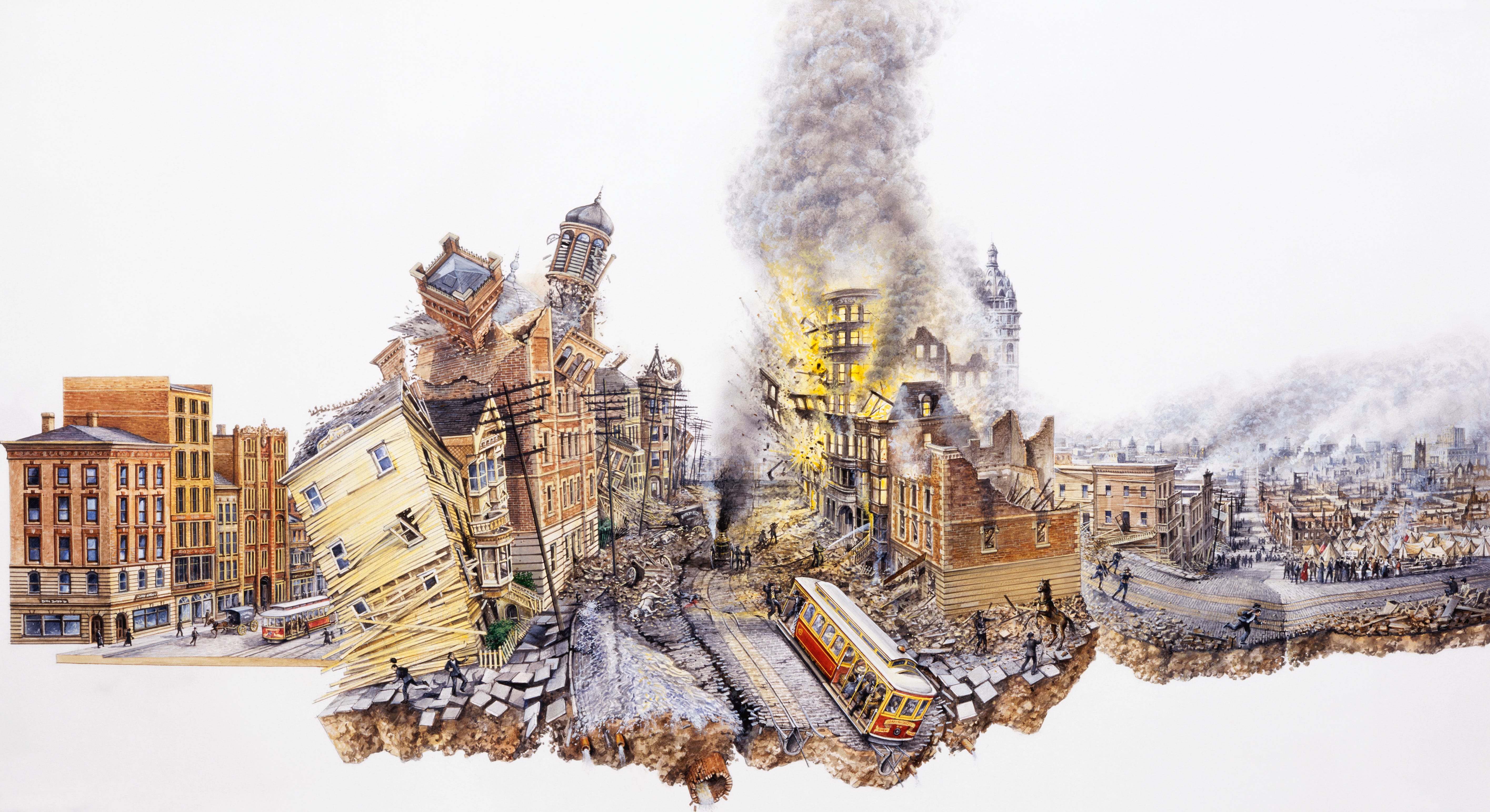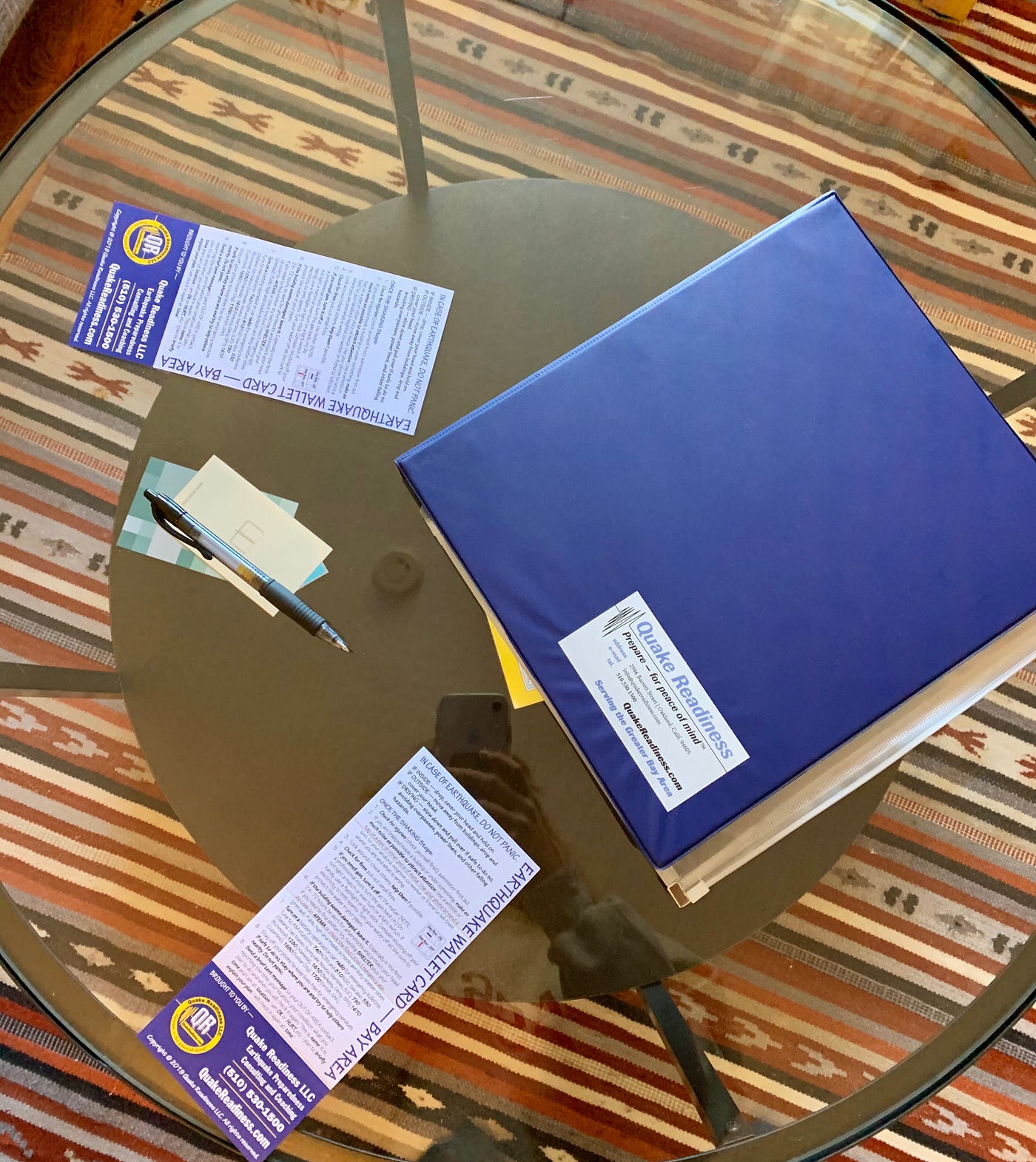
The first time I felt an earthquake was a few months after moving to California in 2013. My boyfriend and I were watching TV when the room rumbled. I turned to him and said, in all seriousness, “Well, that was one heckuva large truck!” He stared at me for a beat, then calmly explained that we lived in such a large apartment building that there wasn’t a truck large enough to move our couch. That, my dear, was an earthquake.
In the years since, I’ve learned a thing or two about earthquakes. At least, I can identify if I’m in the middle of one. But when it comes to actual preparedness, I’ve been admittedly subpar. At one point, I suggested putting bike helmets next to the bed and leaping into the tree off our balcony when the Big One hit. That time, my boyfriend kindly said nothing.
So when I saw a local broadcast segment about a professional “earthquake coach” for hire in Oakland, I knew it was for me.
“If I had lived near Mount Vesuvius, I would have been paying attention to what that volcano was doing.”
Sarah Jones is the founding owner of Quake Readiness LLC. The 52-year-old Oakland resident started her business in 2015 after she grew bored with design work. At what I can only imagine was a highly successful meeting with a career consultant, she identified earthquake preparedness as uniquely suited to her talents, as she grew up in Southern California and experienced both the 5.9 Whittier Narrows quake in 1987 and the 7.2 Cape Mendocino quake in 1992.
“I think I am hardwired to plan for emergencies and contingencies,” she told me after arriving at my apartment in Orinda on a recent Saturday morning. “If I had lived near Mount Vesuvius, I would have been paying attention to what that volcano was doing.”

Clad in flip-flops, a Capt. Andy’s Sailing Adventures visor, and a North Face fleece, Jones wasted no time. She sat on my couch, slapped a fat blue binder on the coffee table, and opened with a line that we’ve all heard far too many times at this point: “There’s a 72% chance that the Big One will occur in the next 30 years.” She paused, her fingertips poised on the binder, letting the statement hang in the air. I’ve been reading about the Big One for so many years now that I’ve grown somewhat numb to it, even bored by it. But Jones’ opening line seemed to say, “Don’t forget — it’s coming.”
She then opened to the first page and proceeded to walk us through the entire binder, which she’d prepared in advance on the basis of research and a detailed questionnaire I’d filled out ahead of time. The binder contained over a dozen pieces of educational content — some that she’d developed herself and others that had been collected from local or national entities. It ranged from a USGS pamphlet on the Earthquake Outlook for the San Francisco Bay Region 2014–2043 to Jones’ detailed guide — “Preparing a Personal Emergency Water Supply” — to printed satellite images of our neighborhood showing historical seismic activity in relation to our address.
One thing was immediately clear: Jones isn’t one to gloss over details, and details, it turns out, matter a lot in emergencies.
After about 30 minutes of walking us through the information and answering questions, it was time for the walk-through. We recently moved into a small two-bedroom in-law unit atop a detached garage in Orinda. Jones proceeded to walk through each room of our place, explaining how and where would be best to take cover, what to secure to the walls or floor, and what is likely to be the most dangerous item.
The hanging plant we have in our living room? “That’ll crack a skull.”
The mortar and pestle we have sitting on top of our fridge? “Oh yeah, that’ll kill ya,” she said seriously, but with a wry laugh.
She then inspected the exterior: the yard, the deck, and the garage. She showed us how to turn off our gas and our water if needed (after helping us find our gas and water hookups), how to siphon drinking water from the water heater as a last resort, and even where we should camp in our yard if the apartment was unsafe to be inside. That’s around when it became clear that details are Jones’ forte.

Finally, she ushered us back inside and had us gather around a neon-green backpack — her homemade, Jones-approved earthquake emergency kit. This is the moment when she went straight-up Mary Poppins, pulling a seemingly endless array of supplies and tools out of a normal-size backpack — everything from normal items such as Band-Aids and batteries to a metal pry bar and a rain poncho.
She sells it, fully stocked, for $350, but she also gives clients a list of what’s inside if you want to make your own. That includes items the client should add, such as cash in small bills or a deck of cards to pass the time. She told me that she created the kit when she failed to find a premade version that met her standards — a fact I had no trouble believing on the basis of her due diligence.
There was a hard hat affixed to the side of the backpack for wearing in a destabilized building or otherwise dangerous area. I piped up, proudly sharing my idea to keep bicycle helmets next to the bed. She was nice enough to smile and nod.
Then she was gone. In a whirlwind hour and a half, I had learned more about earthquakes (and emergency preparedness) than I had in my entire life.
Jones’ home consultations start at around $200, depending on the size of the home. The personalization of her work to her clients’ living situations is perhaps the most valuable element of what she does. However, in the spirit of knowledge sharing, here is a non-exhaustive list of wisdom I gleaned from Jones:
1. Prioritize water above all
If Jones had to pick one element of readiness that’s most important, her answer is water. She recommends 21 gallons per person for three weeks’ worth. You also want backup plans if you’re on the move. She swears by the LifeStraw, a large straw contraption that allows you to filter dirty water into drinking water.
2. Don’t trust a doorway
Jones squashed this old bit of “wisdom” fast. Standing in the doorway is almost never safer than sheltering in place—and could result in smashed fingers if the door swings shut. Instead, huddle in place and cover your head with your arms — or even better, pillows and blankets if they’re available. Be aware of dangerous items in advance. Is there a bookshelf that could tip? Move out of its way.
3. Do know thy neighbors
This that came up more than once. As Jones put it, “We will all have to depend on one another in the event of a major earthquake, especially for the first few days.” She admits that it’s harder in an era of fewer neighborly interactions, but this is about more than just being friendly. In the event of a major quake, your neighborhood will fare far better if you’ve prepared a community plan. For example, this could include committing to checking on an elderly neighbor or someone who works from home promising to grab a neighbor’s pet if there’s a daytime evacuation. Or, Jones suggests, your street could even go in on a communal shed with shared tools and resources.
4. Don’t listen to Dwayne Johnson
According to Jones, the movie San Andreas perpetuates the false myth of a “triangle of life.” I looked up the movie scene in question, which includes the Rock saving a bunch of people by having them huddle against the wall of Oracle Park as the stadium lights crash around them. It’s basically the idea that if you huddle next to a sturdy object, such as a desk or wall, anything that falls on you leans on the desk or wall, leaving you a triangle of safety. It’s a common myth that I, too, fell prey to when I was feverishly googling “how to survive earthquakes” at midnight during my first couple of years out west. In USGS’s estimation, this information is “misguided” at best.
5. Do spread your safety net around
You don’t know whether you’ll have to evacuate immediately or shelter in place, or if you’ll get stuck in your car. That’s why Jones warns against storing all emergency supplies in one place. For example, split up your water in multiple locations and keep a face mask in your car, your desk at work, and in your bedside emergency kit.
6. Don’t underestimate the power of quakes
Having lived through two major quakes, Jones said this was the most common “blind spot” people have. “Many people do not take earthquakes seriously enough. Just because they have felt some, they think, ‘No big deal.’ But they have likely not experienced a major quake, and the difference is exponential,” she said. So just because one quake can be (easily) mistaken for a large truck doesn’t mean that the next one will be so tame.
7. Do have backup plan(s) for your backup plan
Expect the unexpected. What if a tree falls and blocks your planned route of evacuation? Have a secondary route in mind or a wagon you can take by foot. What if you get stuck in the city while your kids are at school in the East Bay? Arrange for someone who lives near their school to be your backup contact. Jones had plan B (and C, D, and E) for nearly every scenario.
My main takeaway from this experience was needing to accept what I can’t control. I need to make peace with the fact that disaster, to some extent, is likely. Jones’ attitude is to accept earthquakes as a fact of life, prepare for them, and carry on. That was evident from the moment she slapped her heavy binder on the table, promising that the Big One ain’t far off. It’s the kind of attitude that allows her to point to an object and say, “That will split a human skull,” then calmly explain the right mirror-hanging hook to buy at the local hardware store.
Before I met Jones, I considered whether she might be the neurotic type, over-worried about dangers around every corner or in every hanging houseplant. In reality, calmness is her most obvious trait. And that’s what she’s trying to help instill in her clients. Thinking through details isn’t about obsessing over an outcome we can’t control; rather, it’s about the opposite.
“It’s easier than one might think, and it need not be expensive to prepare. It does require some courage in facing the fact that major earthquakes are part of life in the Bay Area,” Jones said. “But there is freedom in facing the truth, dealing with it in some commonsense ways, and then getting on with one’s life.”







